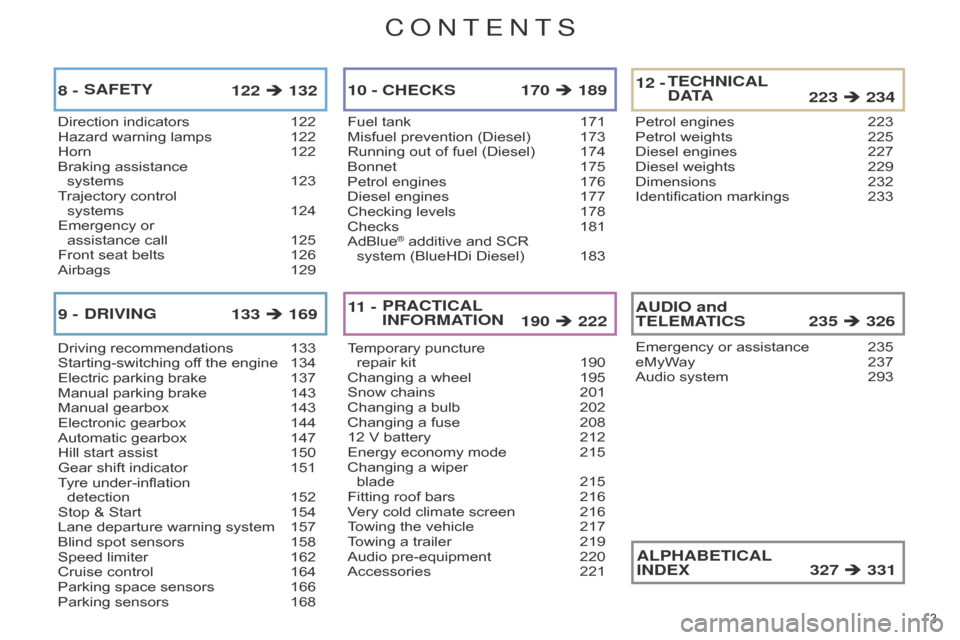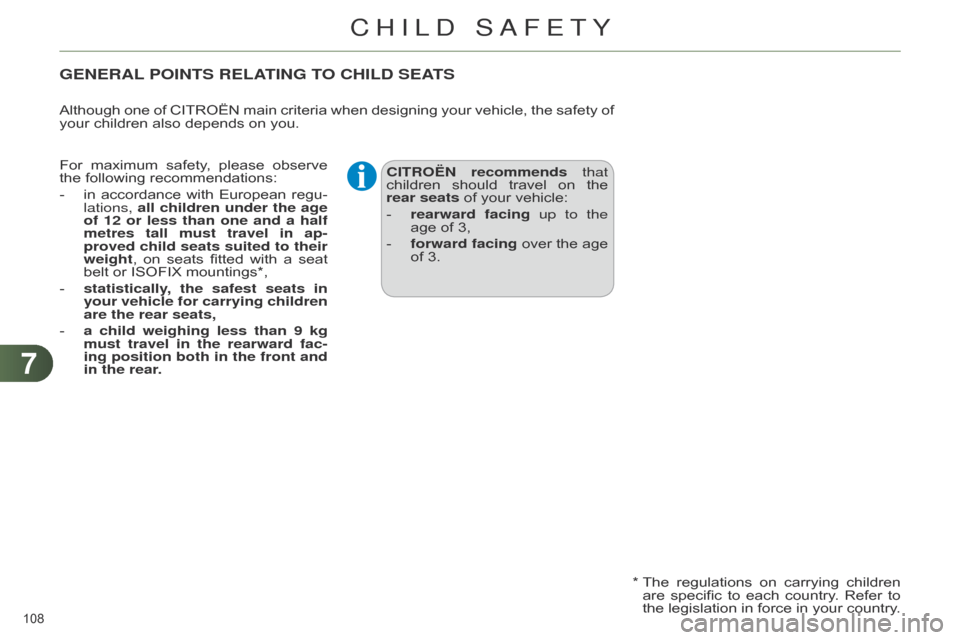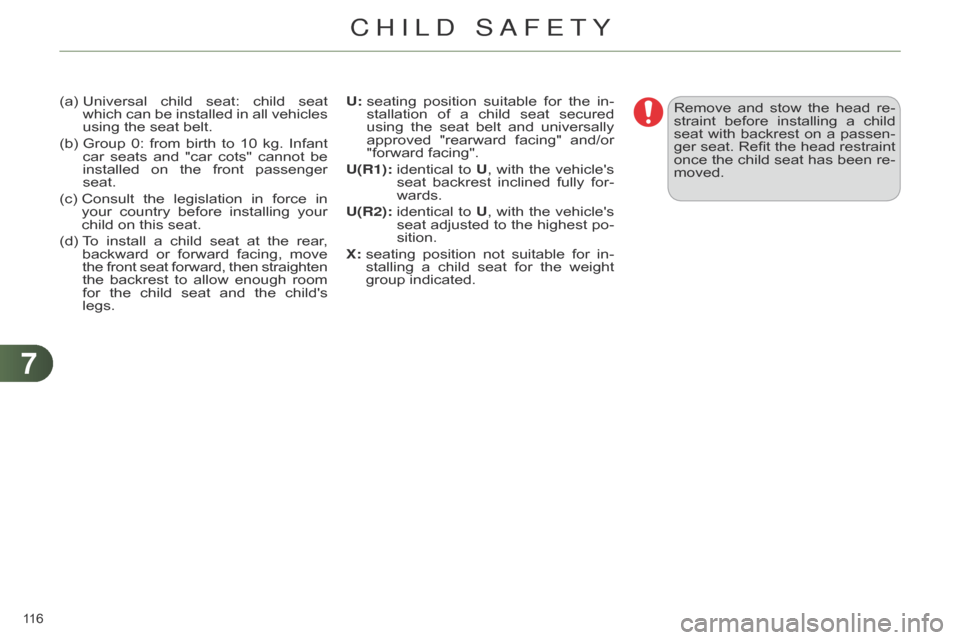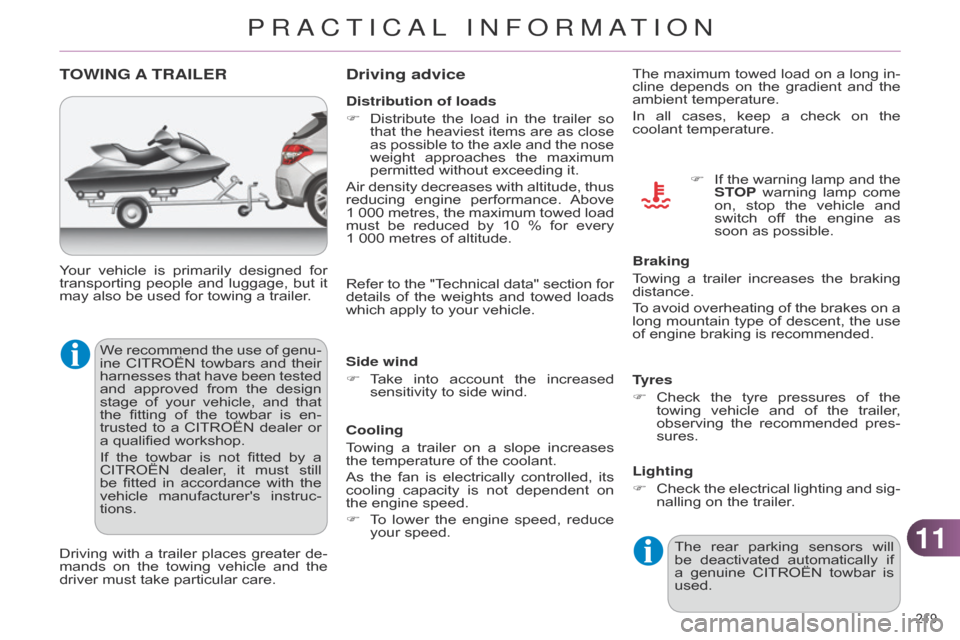weight Citroen C4 DAG 2014.5 2.G Owner's Manual
[x] Cancel search | Manufacturer: CITROEN, Model Year: 2014.5, Model line: C4 DAG, Model: Citroen C4 DAG 2014.5 2.GPages: 340, PDF Size: 12.89 MB
Page 5 of 340

3
C4-2_en_Chap00a_sommaire_ed01-2014
Direction indicators 122
Hazard warning lamps 122
Horn
122
Braking
assistance
systems
123
T
rajectory control
systems
124
Emergency
or
assistance
call
125
Front
seat belts
126
Airbags
129
8 - 122 132
SAFETY
Driving recommendations 133
Starting-switching off the engine 134
Electric
parking brake
137
Manual
parking brake
143
Manual
gearbox
143
Electronic
gearbox
144
Automatic
gearbox
147
Hill
start assist
150
Gear
shift indicator
151
T
yre under-inflation
detection
152
Stop
& Start
154
Lane
departure warning system
157
Blind
spot sensors
158
Speed
limiter
162
Cruise
control
164
Parking
space sensors
166
Parking
sensors
168
9 - 133 169
DRIVING
Fuel tank 171
Misfuel prevention (Diesel) 173
Running
out of fuel (Diesel)
174
Bonnet
175
Petrol
engines
176
Diesel
engines
177
Checking
levels
178
Checks
181
AdBlue® additive and SCR
system (BlueHDi Diesel) 183
10 - 170 189
CHECKS
Temporary puncture
repair kit 190
Changing
a wheel
195
Snow
chains
201
Changing
a bulb
202
Changing
a fuse
208
12
V battery
212
Energy
economy mode
215
Changing
a wiper
blade
215
Fitting
roof bars
216
V
ery cold climate screen
216
T
owing the vehicle
217
T
owing a trailer
219
Audio
pre-equipment
220
Accessories
221
11 - 190
222
PRACTICAL
INFORMATION
Petrol engines 223
Petrol weights 225
Diesel
engines
227
Diesel
weights
229
Dimensions
232
Identification
markings
233
12 - 223 234
TECHNICAL
D ATA
Emergency or assistance 235
eMyW ay 237
Audio
system
293
235 326
AUDIO and
TELEMATICS
327
331
ALPHABETICAL
INDEX
CONTENTS
Page 110 of 340

77
108
C4-2_en_Chap07_securite-enfants_ed01-2014
GENERAL POINTS RELATING TO CHILD SEATS
CITROËN recommends that
children
should travel on the
rear seats
of your vehicle:
-
rearward
facing up to the
age
of 3,
-
forward
facing
over
the
age
of
3.
Although
one
of
CITROËN
main
criteria
when
designing
your
vehicle,
the
safety
of
your
children
also
depends
on
you.
*
The
regulations
on
carrying
children
are
specific
to
each
country
.
Refer
to
the
legislation
in
force
in
your
country
.
For
maximum
safety
,
please
observe
the
following
recommendations:
-
in
accordance
with
European
regu
-
lations, all children under the age
of 12 or less than one and a half
metres tall must travel in ap-
proved child seats suited to their
weight,
on
seats
fitted
with
a
seat
belt
or
ISOFIX
mountings*,
-
statistically
, the safest seats in
your vehicle for carrying children
are the rear seats,
-
a child weighing
less than 9 kg
must travel in the rearward fac-
ing position both in the front and
in the rear.
CHILD SAFETY
Page 117 of 340

77
115
C4-2_en_Chap07_securite-enfants_ed01-2014
LOCATIONS FOR CHILD SEATS SECURED USING THE SEAT BELT
In accordance with European regulations, this table indicates the options for installin g child seats secured using the seat belt and
universally approved (a) in relation to the weight of the child and the seat in the vehicle.
Seat Weight of the child / indicative age
Less than 13
kg
(groups
0 (b)
and
0+)
Up
to ≈ 1 yearFrom 9 to 18 kg
(group
1)
From 1 to ≈ 3 years
From 15 to 25 kg
(group 2)
From 3 to ≈ 6 years
From 22 to 36 kg
(group 3)
From 6 to ≈ 10 years
Front passenger seat (c)
-
fixed U(R1)U(R1)U(R1)U(R1)
-
height
adjustable U(R2)U(R2)U(R2)U(R2)
Outer
rear seats (d) UUUU
Centre
rear seat (d) XXXX
CHILD SAFETY
Page 118 of 340

77
116
C4-2_en_Chap07_securite-enfants_ed01-2014
(a) Universal child seat: child seat which
can be installed in all vehicles
using
the seat belt.
(b)
Group
0:
from
birth
to
10
kg.
Infant
car
seats
and
"car
cots"
cannot
be
installed
on
the
front
passenger
seat.
(c)
Consult
the
legislation
in
force
in
your
country
before
installin
g
your
child
on this seat.
(d)
T
o
install
a
child
seat
at
the
rear
,
backward
or
forward
facing,
move
the front seat forward, then straighten
the
backrest
to
allow
enough
room
for
the
child
seat
and
the
child's
legs. Remove
and
stow
the
head
re
-
straint
before
installin
g
a
child seat
with
backrest
on
a
passen
-
ger
seat.
Refit
the
head
restraint
once
the
child
seat
has
been
re
-
moved.
U:
seating
position
suitable
for
the
in
-
stallation
of
a
child
seat
secured
using
the
seat
belt
and
universally
approved
"rearward
facing"
and/or
"forward
facing".
U(R1):
identical
to
U
,
with
the
vehicle's
seat
backrest
inclined
fully
for
-
wards.
U(R2):
identical
to
U
,
with
the
vehicle's
seat
adjusted
to
the
highest
po
-
sition.
X: seating position not suitable for in -
stalling a child seat for the weight group
indicated.
CHILD SAFETY
Page 219 of 340

1111
217
C4-2_en_Chap11_info-pratique_ed01-2014
TOWING THE VEHICLE
Procedure for having your vehicle towed
or for towing another vehicle us -
ing
a removable towing eye.
The
towing
eye
is
installed
in
the
boot
under
the floor.
To
gain access to it:
F
open the boot,
F
raise
the floor,
F
secure
it
by
hooking
its
cord
on
the
hook
on
the
rear
parcel
shelf
support,
F
remove
the
towing
eye
from
the
holder
.
Access to the tools General recommendations
Observe the legislation in force in your country.
Ensure
that
the
weight
of
the
towing
vehicle
is
higher
than
that
of
the
towed
vehicle.
The
driver
must
remain
at
the
wheel
of
the
towed
vehicle
and
must
have
a
valid
driving licence.
When
towing
a
vehicle
with
all
four
wheels
on
the
ground,
always
use
an
approved
towing arm; rope and straps are prohibited.
The
towing vehicle must move off gently.
When
towing
a
vehicle
with
the
engine
of
f,
there
is
no
longer
any
power
assistance
for braking or steering.
In
the
following
cases,
you
must
always
call
on
a
professional
recovery
service:
-
vehicle
broken down on a motorway or fast road,
-
four-wheel
drive vehicle,
-
when
it
is
not
possible
to
put
the
gearbox
into
neutral,
unlock
the
steering,
or release the parking brake,
-
towing
with only two wheels on the ground,
-
where
there is no approved towing arm available...
PRACTICAL INFORMATION
Page 221 of 340

1111
219
C4-2_en_Chap11_info-pratique_ed01-2014
TOWING A TRAILER
We recommend the use of genu -
ine CITROËN towbars and their
harnesses
that
have
been
tested
and
approved
from
the
design
stage
of
your
vehicle,
and
that
the
fitting
of
the
towbar
is
en
-
trusted
to
a
CITROËN
dealer
or
a
qualified workshop.
If
the
towbar
is
not
fitted
by
a
CITROËN
dealer
,
it
must
still
be
fitted
in
accordance
with
the
vehicle
manufacturer's
instruc
-
tions.
Your
vehicle
is
primarily
designed
for
transporting
people
and
luggage,
but
it
may
also be used for towing a trailer.
Driving
with
a
trailer
places
greater
de
-
mands
on
the
towing
vehicle
and
the
driver
must take particular care.
Driving advice
Distribution of loads
F
Distribute
the
load
in
the
trailer
so
that
the
heaviest
items
are
as
close
as
possible
to
the
axle
and
the
nose
weight
approaches
the
maximum
permitted
without exceeding it.
Air
density
decreases
with
altitude,
thus
reducing
engine
performance.
Above
1
000
metres,
the
maximum
towed
load
must
be
reduced
by
10
%
for
every
1 000
metres of altitude.
Side wind
F
T
ake
into
account
the
increased
sensitivity
to side wind.
Cooling
Towing
a
trailer
on
a
slope
increases
the
temperature of the coolant.
As
the
fan
is
electrically
controlled,
its
cooling
capacity
is
not
dependent
on
the
engine speed.
F
T
o
lower
the
engine
speed,
reduce
your
speed. The
maximum
towed
load
on
a
long
in
-
cline depends on the gradient and the ambient
temperature.
In all cases, keep a check on the
coolant
temperature.
F
If
the
warning
lamp
and
the
ST
OP
warning
lamp
come
on,
stop
the
vehicle
and
switch
of
f
the
engine
as
soon
as possible.
Braking
Towing
a
trailer
increases
the
braking
distance.
T
o
avoid
overheating
of
the
brakes
on
a
long
mountain
type
of
descent,
the
use
of
engine braking is recommended.
Tyres
F
Check
the
tyre
pressures
of
the
towing
vehicle
and
of
the
trailer
,
observing
the
recommended
pres
-
sures.
Lighting
F
Check
the
electrical
lighting
and
sig
-
nalling
on the trailer.
Refer
to
the
"T
echnical
data"
section
for
details
of
the
weights
and
towed
loads
which
apply to your vehicle.
The
rear
parking
sensors
will
be
deactivated
automatically
if
a
genuine
CITROËN
towbar
is
used.
PRACTICAL INFORMATION
Page 227 of 340

225
C4-2_en_Chap12_caracteristique_ed01-2014
* The kerb weight is equal to the unladen weight + driver (75 kg).
**
The
weight
of
the
braked
trailer
can
be
increased,
within
the
GTW
limit,
if
the
GVW
of
the
towing
vehicle
is
reduced
by
an
equal amount. Warning: towing using a lightly loaded towing vehicle may have an adverse effect on its road holding.
PETROL WEIGHTS AND TOWED LOADS ( IN KG )
The GTW and towed load values indicated are valid up to a maximum altitude of 1 000 metres; the towed load mentioned must
be reduced by 10 % for each additional 1 000 metres of altitude.
When
towing, the maximum authorised speed is reduced (comply with the legislation in force in your country).
High
ambient
temperatures
may
result
in
a
reduction
in
the
performance
of
the
vehicle
to
protect
the
engine;
if
the
ambient
temperature
is above 37 °C, limit the towed load.
Petrol engine
VTi 95 THP 110VTi 120
Gearbox Manual Manual Manual Automatic
Model code:
NC... 8FR0HNZ6
HNZ6/1 -/2 5FS05FS9
5FS9/D
-
Unladen
weight
1 200
1 200
1 205
1 270
-
Kerb
weight*
1 275
1 275
1 280
1 345
-
Gross
vehicle weight (GVW)
1 720
1 770
1 765
1 755
-
Gross
train weight (GTW)
on
a 12 % gradient
2 920
2 970
3 065
3 055
-
Braked
trailer (within the GTW limit)
on
a 12 % gradient
1 200
1 200
1 300
1 300
-
Braked
trailer**
(with
load
transfer
within
the
GTW
limit)
1 450
1 450
1 550
1 550
-
Unbraked
trailer
635635640670
-
Recommended
nose weight
75757575
12
TECHNICAL DATA
Page 228 of 340

226
C4-2_en_Chap12_caracteristique_ed01-2014
* The kerb weight is equal to the unladen weight + driver (75 kg).
**
The
weight
of
the
braked
trailer
can
be
increased,
within
the
GTW
limit,
if
the
GVW
of
the
towing
vehicle
is
reduced
by
an
equal amount. Warning: towing using a lightly loaded towing vehicle may have an adverse effect on its road holding.
The
GTW
and
towed
load
values
indicated
are
valid
up
to
a
maximum
altitude
of
1
000
metres;
the
towed
load
mentioned
must
be reduced by 10 % for each additional 1 000 metres of altitude.
When
towing, the maximum authorised speed is reduced (comply with the legislation in force in your country).
High
ambient
temperatures
may
result
in
a
reduction
in
the
performance
of
the
vehicle
to
protect
the
engine;
if
the
ambient
temperature
is above 37 °C, limit the towed load.
Petrol engine
e-THP 130THP 155
Gearbox ManualElectronic
Model code:
NC... HNYM/S
HNYM/1S 5FV8/P
-
Unladen
weight
1 205
1 275
-
Kerb
weight*
1 280
1 350
-
Gross
vehicle weight (GVW)
1 790
1 805
-
Gross
train weight (GTW)
on
a 12% gradient
3 090
3 205
-
Braked
trailer (within the GTW limit)
on
a 12% gradient
1 300
1 400
-
Braked
trailer** (with load transfer within the
GTW
limit)
1 550
1 650
-
Unbraked
trailer
640675
-
Recommended
nose weight
7575
12
TECHNICAL DATA
Page 231 of 340

229
C4-2_en_Chap12_caracteristique_ed01-2014
* The kerb weight is equal to the unladen weight + driver (75 kg).
**
The
weight
of
the
braked
trailer
can
be
increased,
within
the
GTW
limit,
if
the
GVW
of
the
towing
vehicle
is
reduced
by
an
equal amount. Warning: towing using a lightly loaded towing vehicle may have an adverse effect on its road holding.
DIESEL WEIGHTS AND TOWED LOADS ( IN KG )
The GTW and towed load values indicated are valid up to a maximum altitude of 1 000 metres; the towed load mentioned must
be reduced by 10 % for each additional 1 000 metres of altitude.
When
towing, the maximum authorised speed is reduced (comply with the legislation in force in your country).
High
ambient
temperatures
may
result
in
a
reduction
in
the
performance
of
the
vehicle
to
protect
the
engine;
if
the
ambient
temperature
is above 37 °C, limit the towed load.
Diesel engine
HDi 90 HDi 90 FAP BlueHDi 100 e-HDi 115
Gearbox Manual ManualManualManual
Model code:
NC... 9H j C
9H j C/1
9HP0 BHY6
BHY6/1 BHY6/2S 9HD8/S
9HD8/1S 9HD8/2S
-
Unladen
weight
1 248 1 205 1 200 1 205 1 280 1 280
-
Kerb
weight*
1 323 1 280 1 275 1 280 1 355 1 355
-
Gross
vehicle weight (GVW) 1 745 1 790 1 830 1 840 1 820 1 820
-
Gross
train weight (GTW)
on
a 12 % gradient
2 545 2 890 3 130 3 140 3 120 2 220
-
Braked
trailer (within GTW limit)
on
12 % gradient
800 1 100 1 300 1 300 1 300 400
-
Braked
trailer**
(with
load
transfer
with
the GTW limit)
1 050 1 350 1 550 1 550 1 550 600
-
Unbraked
trailer
640 640 635 640 670 400
-
Recommended
nose weight
757575757575
12
TECHnICaL daTa
Page 232 of 340

230
C4-2_en_Chap12_caracteristique_ed01-2014
* The kerb weight is equal to the unladen weight + driver (75 kg).
**
The
weight
of
the
braked
trailer
can
be
increased,
within
the
GTW
limit,
if
the
GVW
of
the
towing
vehicle
is
reduced
by
an
equal amount. Warning: towing using a lightly loaded towing vehicle may have an adverse effect on its road holding.
The
GTW
and
towed
load
values
indicated
are
valid
up
to
a
maximum
altitude
of
1
000
metres;
the
towed
load
mentioned
must
be reduced by 10 % for each additional 1 000 metres of altitude.
When
towing, the maximum authorised speed is reduced (comply with the legislation in force in your country).
High
ambient
temperatures
may
result
in
a
reduction
in
the
performance
of
the
vehicle
to
protect
the
engine;
if
the
ambient
temperature
is above 37 °C, limit the towed load.
Diesel engine
e-HDi 115BlueHDi 115 BlueHDi 120 HDi 150 FAP
Gearbox ElectronicManual Manual Manual
Model code:
NC... 9HD8/1PS 9HD8/2PSBHXM/S
BHXM/1S -/2S BHZM/S
BHZM/1S -/2S RHE8
RHE8/1
-
Unladen
weight
1 205 1 205 1 280 1 280 1 320
-
Kerb
weight*
1 280 1 280 1 355 1 355 1 395
-
Gross
vehicle weight (GVW)
1 825 1 825 1 860 1 860 1 885
-
Gross
train weight (GTW)
on
12 % gradient
3 125 2 225 3 160 3 160 3 385
-
Braked
trailer (within GTW limit)
on
12 % gradient
1 300
4001 300 1 300 1 500
-
Braked
trailer**
(with
load
transfer
with
the GTW limit)
1 550
6001 550 1 550 1 750
-
Unbraked
trailer
635400675675695
-
Recommended
nose weight
7575757575
12
TECHNICAL DATA